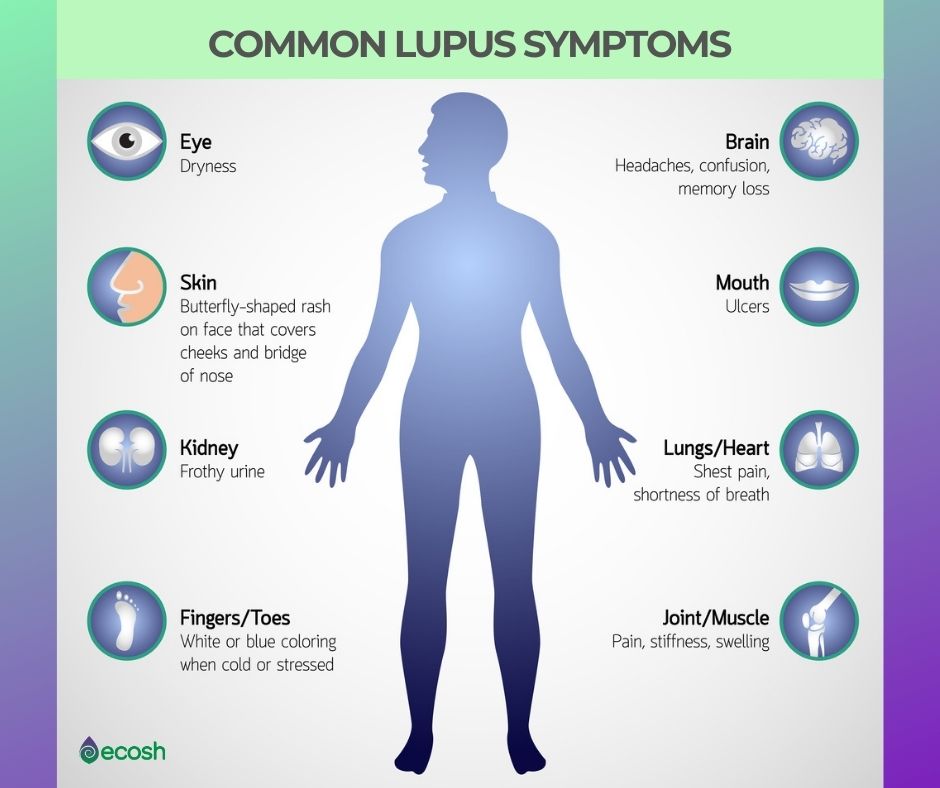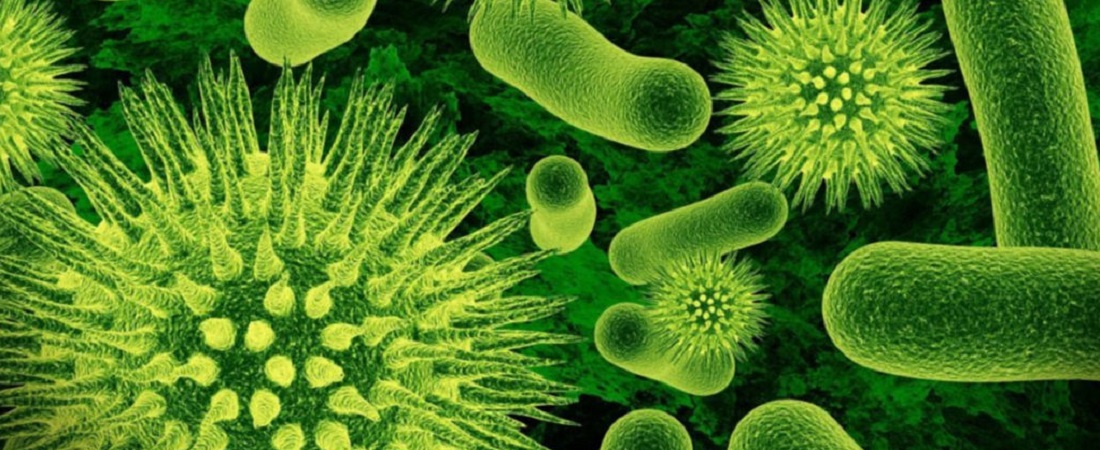Lupus (Systemic Lupus Erythematosus, or SLE) is considered as a chronic disease that causes inflammation of connective tissues. However the causes of lupus are unknown. It can influence any organ in your body including: kidneys, joints, lungs, walls of blood vessels, heart, etc.
Lupus often mimics the symptoms of some other health conditions, such as tiredness, joint pain, swelling, rash, and fever. The symptoms of lupus may vary from person to person depending on the weakest place of the individual. Some will have more external symptoms, such as rash on the skin, while in others the disease manifests itself internally.
About 1.5 million people suffer from some form of lupus in the United States, including some of the well known artists (4).
The disease is more common in women (90% of lupus patients are women), and especially among young women. Also the risk of illness is higher if the disease has previously occurred in the family (4).
Lupus – Causes and Mechanisms
The medical community describes lupus as an autoimmune disease, meaning that some cells no longer distinguish between a person’s own cells and foreign proteins (e.g., bacteria and their poisons).
As a result, antibodies (defence substances) are created that start destroying the body’s own tissues.
Symptoms, or Manifestation
Typical signs of lupus are episodic fevers and overall fatigue. Very common are skin problems; in 80% of the patients, a classic butterfly-shaped rash develops on the face, which is aggravated by the sun.
Skin and mucous membranes may have ulcers, and skin may be itchy. 90% of the patients complain of muscle and joint pain.

Symptoms of Lupus
Some symptoms may materialize years before the next symptoms evolve. Symptoms may also vary in different patients depending on the affected organs or systems. Lupus may manifest itself with a sudden high fever – mimicking an acute viral infection.
Generally, it is rarely known that lupus is caused by viral infection.
Diagnosis of Lupus, as in Which Tests Can Be Done and Why
Early SLE is difficult to differentiate from other connective tissue diseases, such as rheumatoid arthritis, in cases when joint problems dominate. Therefore, the doctor does likely give the diagnosis in the first visit.
Doctor takes a blood test to identify antibodies, as well as inflammatory parameters.
Prognosis
The more severely the disease progresses, the greater the risk of side effects of medicines, which in turn reduces the body’s resistance. In most cases, the course of SLE is chronic, which also includes long periods in which the disease is “resting”, meaning it is in remission. If the acute phase of the disease is under control and the patient is adequately treated, the prognosis is good.
There are also extremely acute forms where the prognosis is very poor (for example, a stroke can occur).
Lupus Treatment Options
You can manage the disease and improve your symptoms with treatment, but it will not go away. Treatment depends on the severity of the disease (6).
- Glucocorticosteroids, or hormonal therapy (long term use) should significantly improve the prognosis. However, with long-term use, there are inevitable side-effects. These include obesity, stomach ulcers, exacerbation of chronic inflammations, and worsening of osteoporosis. Cytostatics suppress the activity of the immune system. Continuous monitoring of blood test results is a must to avoid complications.
- Pulse therapy (in case of acute forms). This means administering large single doses of hormones.
- Blood plasma filtration or plasmapheresis is a process during which specific antibodies are filtered out of the blood. Anti-inflammatory agents (ibuprofen, indometacin, diclofenac) should be used on a long-term basis. In case SLE, physical therapy is contraindicated.
Taking medications can have several side effects. However, failure to treat may have a much more devastating effect. Due to hormone therapy, body weight tends to rise, and fat can be deposited in atypical places, for example, the face may become fatter. The side effects of treatment may also include the damage of the gastric mucosa function or toxic reaction in the liver.
At the same time, you should not fear the treatment, because the resulting benefits may outweigh the potential risks. If any medicine makes a patient feel very bad, another one is tested until the appropriate treatment is found.

Could Lupus Actually be Curable?
The descriptions of the side effects are, to put it mildly, scary, which makes people to seek for other alternative solutions. As written in the article above, the causes of lupus are mostly unknown (5). Also, it is a life-long incurable disease that is not contagious (6). What’s more, it is an autoimmune disease and genetics plays a role. One of these claims is not true according to A. William’s book Medical Medium.
The author of the book writes that the medical circles do not know that lupus is the body’s reaction to the by-products and neurotoxins of the Epstein-Barr virus (EBV). This means that the body has an allergic reaction to these toxins, which increases the level of inflammation markers that doctors seek for to identify and diagnose lupus. In fact, lupus is an Epstein-Barr virus infection.
The medical community knows just one form of EBV, but in reality, there are over 60 forms. EBV is behind a variety of crippling illnesses that confuse doctors. Physicians do not know how the virus affects the body over a long period of time and how large problems it causes. EBV is the cause of many health problems, such as fibromyalgia (inflammation of joints and muscles), chronic fatigue syndrome, thyroid disorders, vertigo, and tinnitus.

The Story of a Person Suffering From Lupus
On March 27, 2007, Anne, who suffers from lupus describes the course of her illness. Anne’s mother died of cancer when Anne was still a teenager. Anne herself was sick a lot during school. At 19 years old, she had thyroid gland operation.
Doctors thought that this was a consequence of the events she had suffered from, which it certainly was, but not only, as the stress Anne had felt due to her mother’s death could have activated the Epstein-Barr virus.
Due to damaged cartilage, it was necessary to operate her knee. After that, she used crutches for half a year. The doctor didn’t dare to operate the other knee, maybe it was due to her heart valve disorder. Thyroid diseases and lupus are both considered to be diseases that we do not know the causes of, and we do not know how to cure them. Yet, Anne must take handfuls of pills each day.
This is one story out of millions around the world, which is actually caused by the Epstein-Barr virus and which can’t be diagnosed, not to mention cured. It is most likely that Anne’s mother died because of the havoc that EB virus caused, and Anne got infected as well. In fact, all these diseases cannot be considered as isolated, but all these symptoms are the consequences of the development of the EB virus.
For example, the well-known pop musician Selena Gomez herself said that she had to undergo chemotherapy because of lupus (8). Braxton, another famous singer, suffers from lupus that mainly attacks the heart of the singer. One of the singer’s uncles died because of lupus complications, and her brother also suffers from lupus. All this refers not to genetics but to infection.

Epstein-Barr Virus and its Discovery
Although the Epstein-Barr virus was discovered by two prominent physicians in 1964, it actually began to affect in the early 20th century – more than half a century earlier.
The original versions of EBV – which are still with us, function relatively slowly and may only lead to significant symptoms towards the end of human life. And even then, they only damage moderately.
Unfortunately, EBV has evolved over the decades and every new generation of the virus has become more dangerous than the previous. Doctors rarely identify EBV as a root cause of many problems. Besides that, they are not sure how to treat EBV, even if it is identified.
How do People Get Infected With The EB Virus?
There are many ways to get EBV. For example, you can get it:
- As a baby, if your mother has the virus
- With infected blood, for example through blood transfusion (hospitals do not screen for this virus)
- From chefs that have a cut in their finger and it gets into the food
- With bodily fluids – sex, kissing
The virus is always not infectious. The virus is most likely to spread in its second stage. EBV goes through at least four stages.

The First Stage of The Epstein-Barr Virus
When you become infected with EBV, it undergoes an initial latent period, floating in your bloodstream without doing much more than copying itself to increase its abundance and is waiting for the opportunity to initiate a real infection.
For example, if you exhaust yourself for weeks and do not give yourself the chance to fully recover or leave your body without essential nutrients, such as zinc or B12, or if you experience a dramatic event such as breaking up or death of a close person, the virus will discover your stress hormones and take advantage of that moment.
EBV also often acts when you undergo a significant hormonal change – such as puberty, pregnancy, or menopause. For women, delivery is a typical scenario. These are the main reasons why young women get lupus. In that case, EBV does not use your weakness, but the fact that hormones are its powerful source of food – their abundance acts as a trigger.
The virus can wait for its time for weeks, or even for many years. In the first stage, the virus is particularly vulnerable. However, it is not detectable at this stage and does not cause any symptoms, therefore, you usually do not know to fight it, because you do not have an idea about its existence.

The Second Stage of The Epstein-Barr Virus – Mononucleosis
At the end of the first stage, EBV is ready to fight your body. It is exactly then, that its existence becomes known and causes mononucleosis. This is the infamous mono, which we hear of as the “kissing disease” when growing. It is a disease that thousands of university, who tire themselves with partying and studying get every year. The medical circles do not know that each case of mononucleosis is the second stage of EBV. This is the period when the virus is the most contagious.
You must avoid contact with someone else’s blood, saliva, or other bodily fluids if they have mono, or if you have mono. It turns out that lupus, or indeed the EB virus, is contagious, not hereditary.
During the second stage, your immune system will go to war against the virus. It sends the detecting cells to “mark” the viruses, that is, to attach hormones to them that mark them as intruders. Then it sends soldier cells to look for and destroy the labelled viruses. This is the power of your immune system in defensive mode.
How fierce this battle is varies between people, and it also depends on which form or strain of EBV it is. You may suffer from mononucleosis for a week or two, and experience moderate to severe sore throat and tiredness, in which case you are unlikely to understand what’s going on, and you will not go to your doctor to do a blood test.
But you can also be experiencing such fatigue, sore throat, fever, headache, rash, and so on that lasts for several months. When this happens, you are likely to go to a doctor who will check your blood, and EBV will manifest itself in the form of mononucleosis mostly. At this stage, EBV is looking for a permanent home, hiding in one or more of your most important organs – typically liver and/or spleen.
EBV likes to be in these organs, because heavy metals accumulate in them, such as mercury, dioxins, and other toxins. The virus thrives on these toxins. Apart from hormones, heavy metals are a good food for the virus. In the case of lupus, it is important to properly clean the organism from heavy metals and other toxins.
One of EBV’s secrets is that he has a best friend, a bacterium called Streptococcus. In this case, the body is busy not only with the virus, but also with the bacteria. This, however, makes the immune system even more confused and creates several other symptoms.
In the second stage of EBV, Streptococcus can infect the throat, sinuses, nose, and the mouth. It can also move downwards and cause infections in the urinary tract, vagina, kidneys, or bladder – ultimately causing cystitis.

The Third Stage of The Epstein-Barr Virus
When the virus has established itself in the liver, spleen, and/or other organs, it will remain nesting. From this time, the doctor will find antibodies in case of an EBV study and thinks they are indicators of a past infection from the time when EBV was in the phase of mononucleosis. Your doctor will not find EBV to be active in the bloodstream. Precisely this confusion is one of the biggest mistakes in the history of medicine – this is the way EBV has fallen through the cracks.
If you have not already implemented the remedies described in the book Medical Medium to eliminate EBV, the virus is actually still alive. It causes new symptoms, and remains inaccessible for research. This is because it lives in the liver, spleen, or other organs, and a study to detect it has not yet been created.
If the virus is hiding unidentified in your organs, the body concludes that it has destroyed the invader and won the battle. The immune system returns to its normal state, mononucleosis passes, and your doctor will tell you that you are healthy. Unfortunately, the Epstein-Barr virus has just started its journey through your body.
- If you have a typical form of EBV, it may persist for many years in a sedentary state – possibly decades – without you knowing it.
- But if you have a particularly aggressive form of EBV, it can cause serious problems.
The virus waits for a suitable time until it notices stress hormones that indicate that you are in a particularly vulnerable state. For instance:
- If you are burning the candle from both ends
- If you have experienced a severe emotional shock or are suffering from a physical shock, for example, from a car accident
- Or if it notices a hormonal change, for example pregnancy or menopause
When the virus is almost ready to attack, it begins to secrete neurotoxin. It adds to the burden on the body that has already been caused by EBV by-products and bodies. All this poison in your body will eventually trigger the immune system and, at the same time, makes it completely confused, because it has no idea where the toxins are coming from.

Epstein-Barr Virus and The Immune System
When the immune system is confused, EBV uses chaos to leave the organ in which it had nested and escapes to another organ or gland, which in this case is the thyroid gland. EBV invades the thyroid gland for strategic reasons – it tries to disrupt the immune system and put pressure on it.
Pressure on the adrenal glands produces more adrenaline, which is EBV’s favourite food and makes it stronger and more capable of attacking its final target – the nervous system. The ultimate goal of Epstein-Barr virus is to leave the thyroid gland and cause inflammation in the central nervous system, which is also the fourth stage of EBV.
The disoriented immune system is what physicians call an autoimmune disease. In fact, the body never works against itself, but does its utmost to restore health. Especially when you:
- Clean the body from poisons (toxins and viruses)
- Provide the right food and avoid damaging foods
- Take supplements and herbal preparations
- Solve the causes of stress, difficult emotional conditions, false beliefs, etc.
In this sense, lupus is an autoimmune disease because people often work and act against themselves. For example, as was written in the Businessinsider, Tony Braxton, who suffers from lupus said she was able to reach a point where she could perform again by educating herself about the disease and using CBD to cope with her symptoms and flare-ups. She also opened up about how living with lupus has affected her career and personal life (7).
NB! The information provided here is for informational purposes only, so do not consider it as health care or medical diagnosis and treatment. Do not consider this information as a guarantee of the results you want to achieve. In addition, this information is not intended to replace the advice of your physician or other healthcare professional. Even more, you should not use it to diagnose or treat a health problem. Before changing or discontinuing your existing medication, treatment, or care, or taking any dietary supplements, be sure to consult with your healthcare professional or doctor before starting any diet or program, or if you suspect you may have a medical condition.EBV often manifests itself in a state of stress, so you must learn to take care of yourself. Relax, laugh, eat high quality pure foods, be active in fresh air, spend a lot of time in the nature, and live a balanced life. You can read about the precise treatment and body detoxifications in the book Medical Medium.
Sources:
- A. William’s book Medical Medium
- The Magazine What Doctors Don’t Tell You, August 2018 No. 8 (44).
- https://www.ncbi.nlm.nih.gov/pubmed/17121489
- https://www.verywellhealth.com/lupus-information-2249963#:~:text=1%EF%BB%BF-,About%20Lupus,and%2045%20years%20of%20age.
- https://www.mayoclinic.org/diseases-conditions/lupus/symptoms-causes/syc-20365789#:~:text=It%27s%20likely%20that%20lupus%20results,cases%2C%20however%2C%20is%20unknown.
- https://www.womenshealth.gov/lupus/lupus-diagnosis-and-treatment
- https://www.businessinsider.com/toni-braxton-interview-lupus-cbd-uncle-buds-garrett-greller
- https://en.wikipedia.org/wiki/Selena_Gomez



